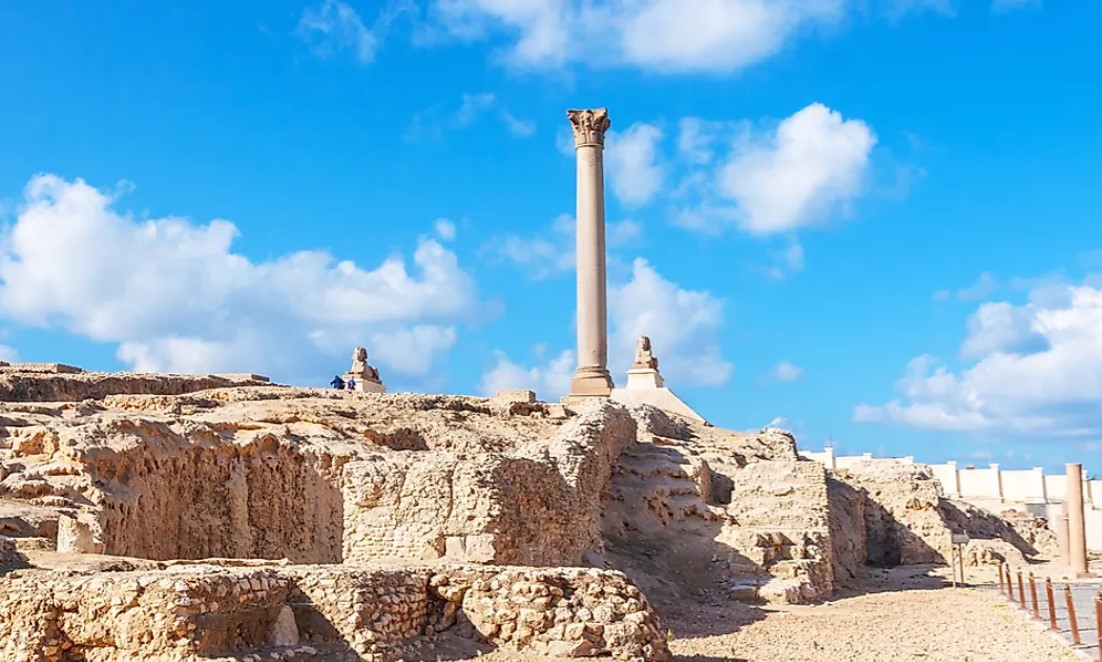Pompey’s Pillar, Alexandria Egypt | Description | History | Facts
In this article, we will give valuable information about Pompey’s Pillar, the history of the Pharaonic monuments surrounding the pillar, the reason behind the name, the entrance fee of Pompey’s Pillar, working hours, and more
What’s Pompey Pillar?
Pompey’s Pillar is considered one of the oldest and highest memorial columns in the world. Meanwhile, it is one of the top tourist attractions in Alexandria.
Where is Pompey’s Pillar of Alexandria?
Pompey’s Pillar is located in the western section of the city of Alexandria. It was built on the Bab Sidra hill, between the current Islamic cemetery area known as the Amoud tombs and the ancient Kom el-Shoqafa plateau.
Almost all Egypt travel packages that include a visit to Alexandria, include the excursion to Pompey’s Pillar, Kom El Shoqafa, and the Roman Amphitheatre.
Why is it called Pompey Pillar?
This single column standing on a rocky hilltop in the middle of Alexandria has nothing to do with Roman General Gaius Pompey. The name started to come to light In the Middle Ages when the Crusaders thought that the head of Pompey (the Roman commander who fled to Egypt to escape from Julius Caesar and was killed by the Egyptians. Thus, thought that his head had been placed in a pot placed over the crown of the column.
The name of the column dates back to the Arab era, where it is believed that it came as a result of the height of this towering column among 400 other columns, which resemble masts (ship masts), and that is why the Arabs called it “the masts column the masts later.
History of Pompey’s Pillar
Pompey’s pillar is one of the remarkable structures that were built during the reign of emperor Diocletian in Egypt. The column is now standing in the heart of Alexandria on top of a temple ruin (Serapeum) that was built during the Ptolemaic kingdom in 297 ADS.
The Serapeum was the sanctuary dedicated to Serapis, the head of the Alexandrian divine triad during the Greco – Roman period. Serapis was a deity created by the Ptolemies, with features of the Egyptian gods Osiris and Apis, and a physical appearance similar to the Greek gods.
Most historians agree that Pompey’s pillar was built in 298 ADS, in honor of the Roman Emperor Diocletian. This can be proved by the note on the western side of the base of the pillar (to the most just Emperor, tutelary of Alexandria Diocletian, the invincible, Postmus, the Prefect of Egypt (who erected this monument).
Description of Pompey’s Pillar
Pompey’s pillar is one single-piece huge column of red granite from Aswan and it consists of the base and the Column itself with its capital.
The material – Red granite from Aswan quarries
Base Diameter – 2.8 meters
Column – stands for about 28 meters including the base and the capital
Capital – is of Corinthian type and made of grey granite
Weight – is estimated to be 280 tons
Pompey’s Pillar, along with other Alexandria historical sites such as the Roman Amphitheatre, Qaitbay Citadel, and the Library of Alexandria is a must-see sight of Alexandria.
Who built Pompey’s pillar?
The Roman ruler of Egypt erected this memorial column between 284-305 A.D. in honor of the Roman Emperor Diocletian. During the Alexandrian revolt against the Roman Emperor Diocletian and after he came himself and sieged the city, there was a famine in the city. The emperor ordered that a part of the corn, which was sent to Rome, be given to the people of Alexandria. He exempted them from paying taxes during these hard times. That was the reason why they built that huge column. “Postmus a governor of Alexandria erected this pillar in honor of a just emperor Diocletian.”
Pharaonic monuments surrounding the pillar
Around the Pillar or the commemorative Column of Diocletian, there are some Pharaonic monuments that can be seen, for example
- On the backside, there are the remains of a Serapeum or a temple of the God Serapis. It is now damaged. In fact, it was built during the reigns of Ptolemy II and Ptolemy III. It was damaged due to the revolts of the Jewish population in Alexandria
- There are two sphinxes made of pink granite, one of them dating to the era of Ptolemy IV and the other of gray granite without a head dating to the era of Horemheb of the eighteenth dynasty.
- A statue of the King Psamtik I of the 26th dynasty of black granite,
- A statue of King Ramesses II missing the head from the 19th dynasty of red granite, and another statue of Ramses II of black granite kneeling
Pompey’s Pillar entrance fee
You can purchase an Entrance ticket for Pompey’s pillar from the Ticket window which is facing the entrance of the visitor center.
Adult: EGP 80 (4 $)
Students with valid cards: EGP 40(2 $)
Children aged 6-12 years: EGP 40 (2 $)
Children under 6 years: FREE
Pompey’s Pillar Opening Hours
Pompey’s Pillar is almost open all week from 09.00 AM to 17.00 PM



Comment (0)